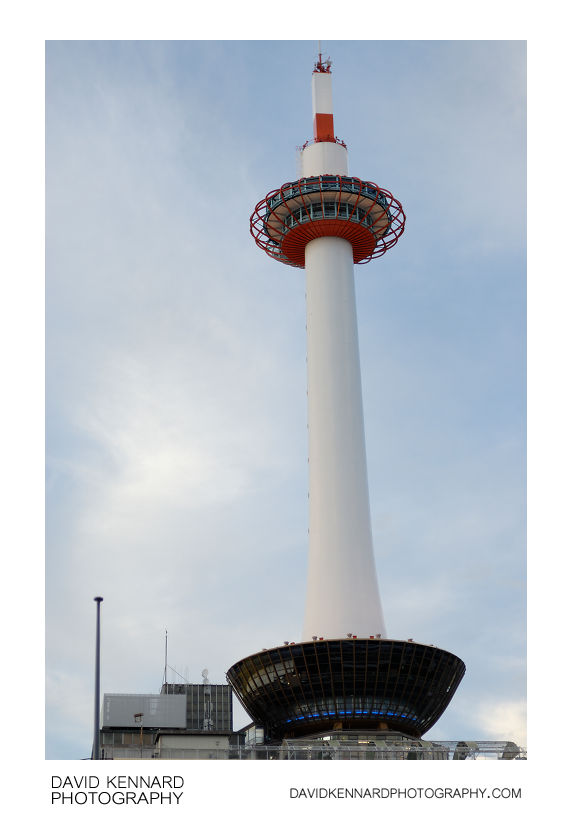Kyoto Tower

Description
- Title:
- Kyoto Tower
- Caption / Description:
-
Kyoto Tower (京都タワー; Kyōto-tawā) is an observation tower located in Kyoto, Japan. The steel tower is the tallest structure in Kyoto with its observation deck at 100 metres (328 ft) and its spire at 131 metres (430 ft). The 800 ton tower stands atop a 9-story building, which houses a 3-star hotel and several stores. The entire complex stands opposite Kyoto Station.
Kyoto Tower was proposed in the early 1960's, and it was planned to be constructed and completed in time to correspond with the 1964 Summer Olympics in Tokyo. Construction began in 1963 on the former site of Kyoto's central post office and was completed near the end of 1964.
Unlike many other towers, such as Tokyo Tower that are constructed using metal lattice frames, Kyoto Tower's interior structure consists of many steel rings stacked on top of each other. The structure was then covered with lightweight steel sheets with a thickness between 12–22 mm (0.47–0.87 in). The sheets were then welded together and painted white. The intended overall effect was for the tower to resemble a Japanese candle.
Designed by Makoto Tanahashi, a doctor of engineering at Kyoto University, Kyoto Tower was built to withstand the forces of both earthquakes and typhoons. The head of the tower's business division, Tsuyoshi Tamura, claims it can withstand winds of up to 201 mph (90 m/s) and survive an earthquake of far greater magnitude than that of the Kobe or Tokyo earthquakes.
The tower was first opened to the public on December 28, 1964. Within its first year of opening, 1 million people visited the tower's observation deck. Throughout the years, the tower's draw as a tourist attraction has diminished. By 1999, observation deck ticket sales dropped to less than 400,000 a year, or about 1,000 a day.
Description adapted from Wikipedia article: http://en.wikipedia.org/wiki/Kyoto_Tower
- Tags / Keywords:
-
- Asia
- Japan
- 日本国
- Nihon-koku
- Kansai region
- 関西地方
- Kansai-chihō
- Kinki region
- 近畿地方
- Kinki-chihō
- JPN
- Kyoutofu
- Shijōdōri
- Kyoto Prefecture
- 京都府
- Kyōto-fu
- Kyoto
- Shimogyō-ku
- 下京区
- Higashishiokoujichou
- Kyoto Tower
- 京都タワー
- Kyōto-tawā
Admin
- Date Original Photo Taken:
- Original File Name:
- _DSC1204a.nef
- Event:
- Rating:
- ☆
- Date this image added/last updated on website:
- Original File Dimensions:
- 2592px x 3872px
- File Type:
- JPEG
- Color Mode:
- Original Image Color Profile:
- Nikon Adobe RGB 4.0.0.3001
Location
- Location Shown:
-
- Sublocation:
- City:
- Kyoto
- Province/State:
- Kyoto Prefecture
- Country:
- Japan
- World Region:
- Asia
- Location Created:
-
- Sublocation:
- City:
- Kyoto
- Province/State:
- Kyoto Prefecture
- Country:
- Japan
- World Region:
- Asia
- Geo-location:
- 34.986455, 135.75921833333 View on map
Rights
- Copyright Status:
- Copyrighted
- Licensing Status:
- Rights Managed
- Available for Editorial Use:
- Yes
- Available for Commercial Use:
- No
- Copyright Notice:
- © 2009 Dave Kennard
Camera Data
- Date Digital Resource was created:
- Shutter speed:
- 1⁄1250 s
- Aperture:
- f/2
- Camera Model:
- Nikon D200
- ISO:
- 200
- Exposure Compensation:
- 0
- Focal Length:
- 50mm
- Focal Length (35mm equiv.):
- 75mm
- Metering Mode:
- Multi-segment
- Flash:
- No Flash
- Exposure Mode:
- Auto
- White Balance:
- Manual
- Light Source:
- Cloudy
- Exposure Program:
- Aperture-priority AE
Additional shooting metadata
- Lens:
- Nikon AF Nikkor 50mm F1.4D
- Filters used:
- Additional Optics used:
- Setup:
- Handheld
Post Processing
- Image Modified:
- Software used:
-
- Nikon Capture NX 2
- Post Processing:
Color Control Point used in CNX2 to brighten tower
